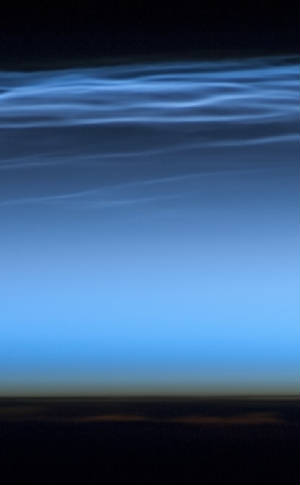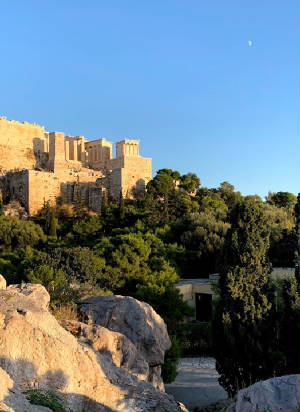|
|
This trilogy looks at different aspects of Earth and society as viewed from outer space, and was presented
at 'Geopetry 2020', an event held on National Poetry
Day and hosted by the Geological Society, the Scottish Poetry Library and the Edinburgh Geological Society. Selected poems
and essays from this event are now published in the book Earth Lines Earth Lines: Geopoetry and Geopoetics - Edinburgh Geological Society (edinburghgeolsoc.org) Just
to remind you, satellites are essential to modern society - there are currently 2000
active satellites orbiting the Earth, out of a total of 8,900 that have been launched since the first (Sputnik, in 1957). The first
poem is inspired by Yuri Gagarin, the first astronaut in space, while the second is a reflection on climate change and other
human impacts on our world, partly inspired by a more recent hero, Greta Thunberg. The third poem 'The Bubble' makes use of
a physio-chemical analogy to explain the fragility of our civilization, originally inspired by the rise and fall of Greek
civilization, hence the link to the Parthenon. See the video version of this poem
at https://vimeo.com/534931379 As
an end piece, and reflecting on famous poems inspired by Earth's original satellite, I have included the well-known poem "Under
the Harvest Moon" by Carl Sandburg (1878-1967). |

|
| Noctilucent clouds in the upper atmosphere (NASA) |
The First Alien
In preparing for arrival on planet Earth
the first alien skimmed the top of the atmosphere
(at an altitude of 170 km) and prepared for rotation and entry.
The autopilot aligned the spacecraft for retro-burn
but
unfortunately the support module failed to separate
from the craft –
a spherical capsule about two metres wide. After a series of rapid gyrations
the two modules eventually
separated over north Africa
and the correct Earth-entry alignment was achieved. Descending
into the Earth’s ever thickening atmosphere
caused the craft to decelerate
with force of about 8 G;
but somehow the occupant managed to remain conscious. Then,
at about 7000 metres from the Earth’s surface
the hatch of the spacecraft
was released
and the creature ejected, deploying a parachute. About
ten minutes later the alien landed,
at 11.05 hours, at a point about 26 km
south west of Engels
(a town in the Saratov region of the Volga district of Russia).
The first people to meet this visitor from
outer space
were a farmer and his daughter, and not surprisingly,
they were rather astonished and somewhat alarmed.
The girl exclaimed: Can it be that you have
come from outer space?
to which the alien replied: V samom dele, u menya yest!
(which calmed the girl as she also understood Russian).
He went on to explain that he had indeed travelled
from
outer space and needed to find a telephone
to call Moscow.
|
Offshore Newfoundland
Using wi-fi in the sky, a twinkle in my eye sparkles with amazement
and joy
as I watch Greta's latest
video diary broadcast from
her yacht while sailing in a gale
offshore
Newfoundland.
I was texting my bro' and my daughter about her show
(also sparkling with amazement and joy)
and making plans for the weekend and the days ahead
broadcasting from an airliner cruising at altitude
offshore Beachy head.
Not many of us appreciate
that we third-millennial apes
depend
so heavily on 2000 orbiting satellites
sparkling in the sky, sending and receiving
positions, coded trains of data, and sensing the Earth
from geostationary orbits.
I tell my students and other reluctant astronauts
(sparkling with amazement and joy)
that modern human civilization would not be possible
without space technology - especially
the GPS sats
spinning in medium
Earth orbits.
And yet these orbiting jewels are the bearers of bad news
(sparkling with doom and gloom) -
we are rapidly destroying our habitat
burning forests and fuels, contaminating and destroying the Earth's biosphere,
atmosphere, hydrosphere and geosphere. All eyes are on their devices
all eyes are saying ‘look at me'
bringing a little sparkle, amazement and
joy
to the here and now.
But our future depends on using
our eyes in the sky, saying ‘looking at
you'
since these could bring
sparkle, amazement and joy
back
to the future.
You know the saying ‘the
ayes have it'
well, indeed they
do.
It is more a question of
which eyes will have it -
the
eyes on the ground or the eyes up there? The Bubble Civilization
is a thin, fragile membrane:
one molecule thick, spreading infinitely, yet contained
like a bubble with multiple curves and topological twists,
refracting the light into myriads of colours,
a birefringent, prismatic shimmer,
watchable forever.
The flaws,
knots and twists
are healed by chemical spreading, remarkably,
in spite of, and because of, the tension. Complexity,
elasticity and the unfathomable bonds of history
provide its flexibility, whilst the growth of
homogeneous mono-molecularity
brings new and dangerous
fragility.
Sustain and enjoy
human and cultural diversity
in Africa, Asia,
Europe, Australasia,
the Americas and islands of the seas.
Resist all the disjoining pressures,
for the spread
of uniformity
only makes the bubble
more likely to
pop.
|
|
| |
|
Under the Harvest Moon
Carl Sandburg -
1878-1967 Under the harvest
moon,
When the
soft silver
Drips
shimmering
Over
the garden nights,
Death, the gray mocker,
Comes and whispers to you
As a beautiful friend
Who remembers.
Under the summer roses
When the flagrant crimson
Lurks in the dusk
Of the wild red leaves,
Love, with little hands,
Comes and touches you
With a thousand memories,
And asks you
Beautiful, unanswerable questions.

|
| Moon over the Parthenon |
|
|
 |
 |
 |
|